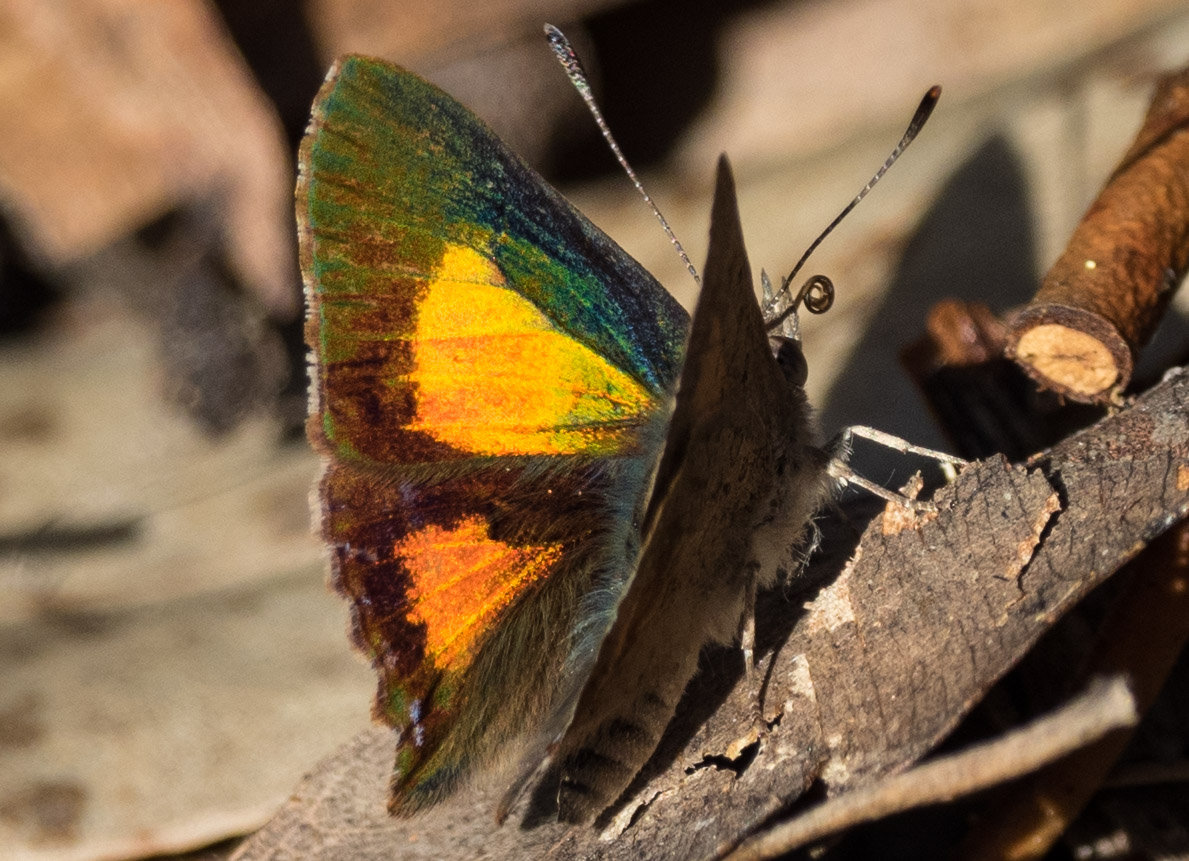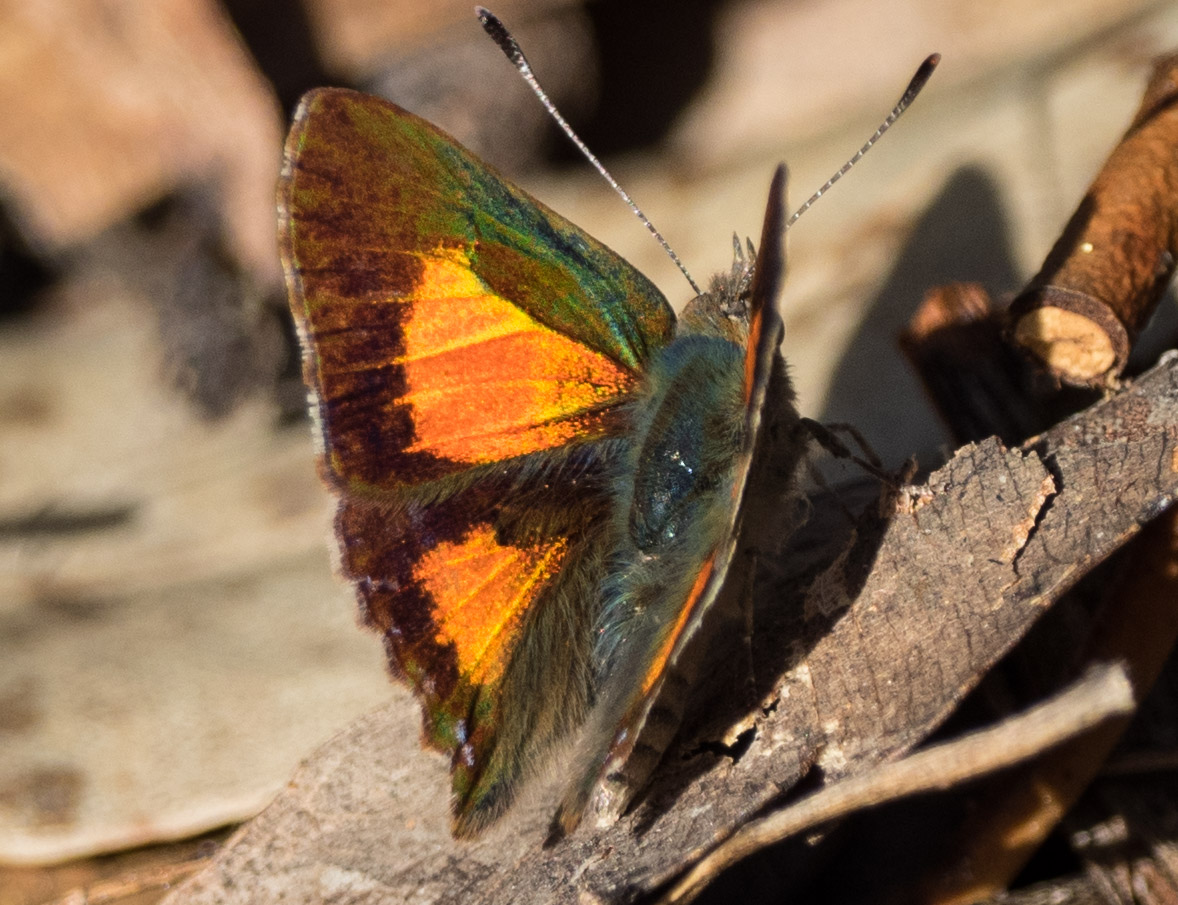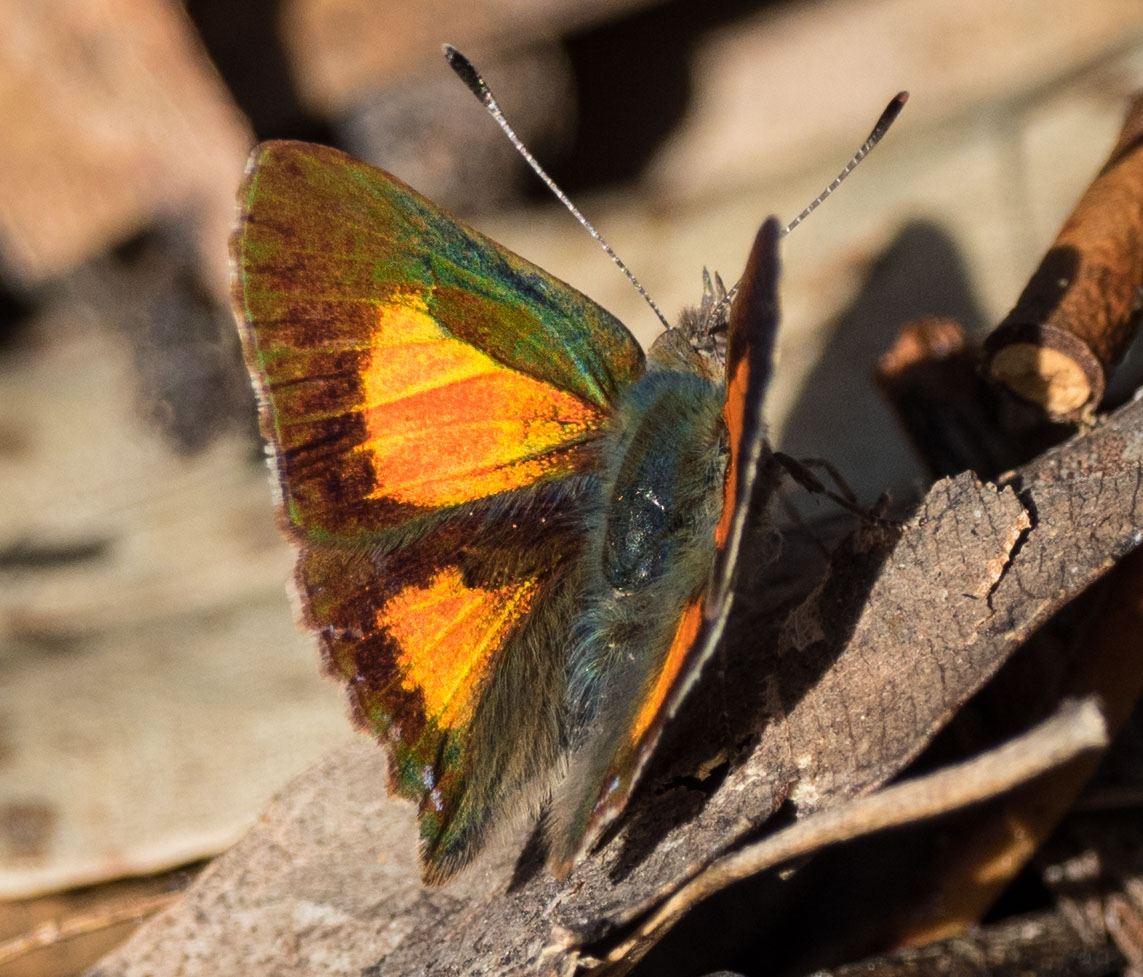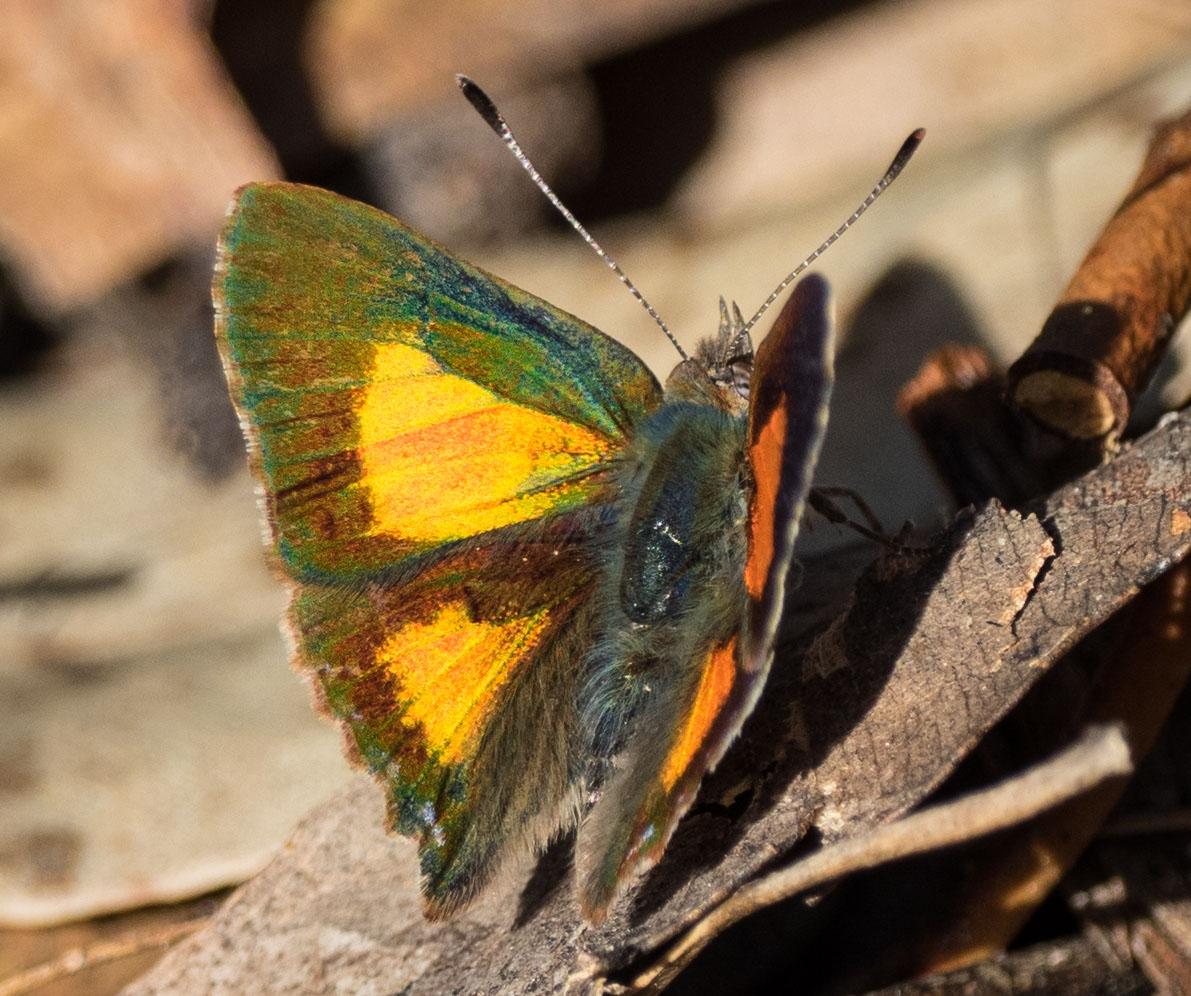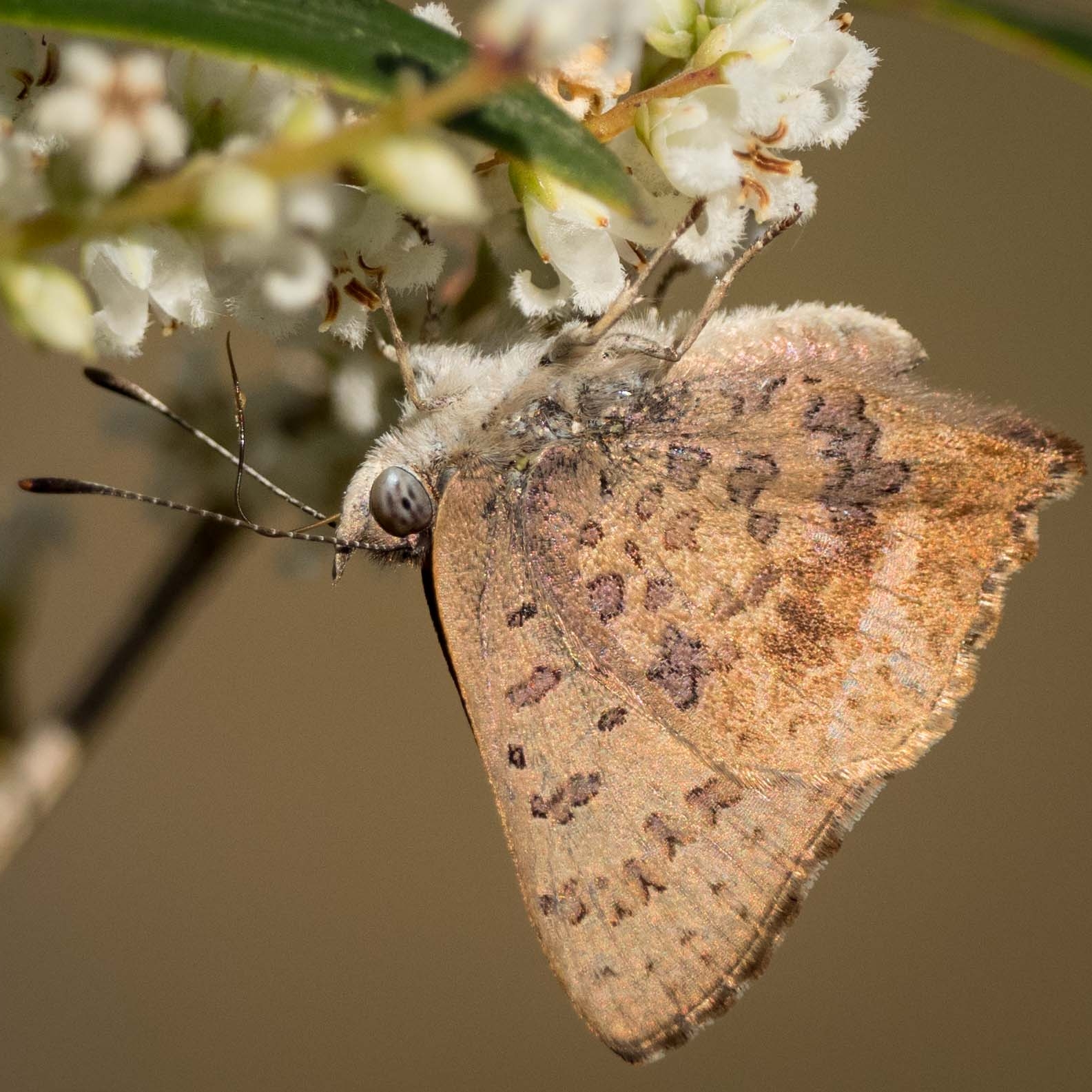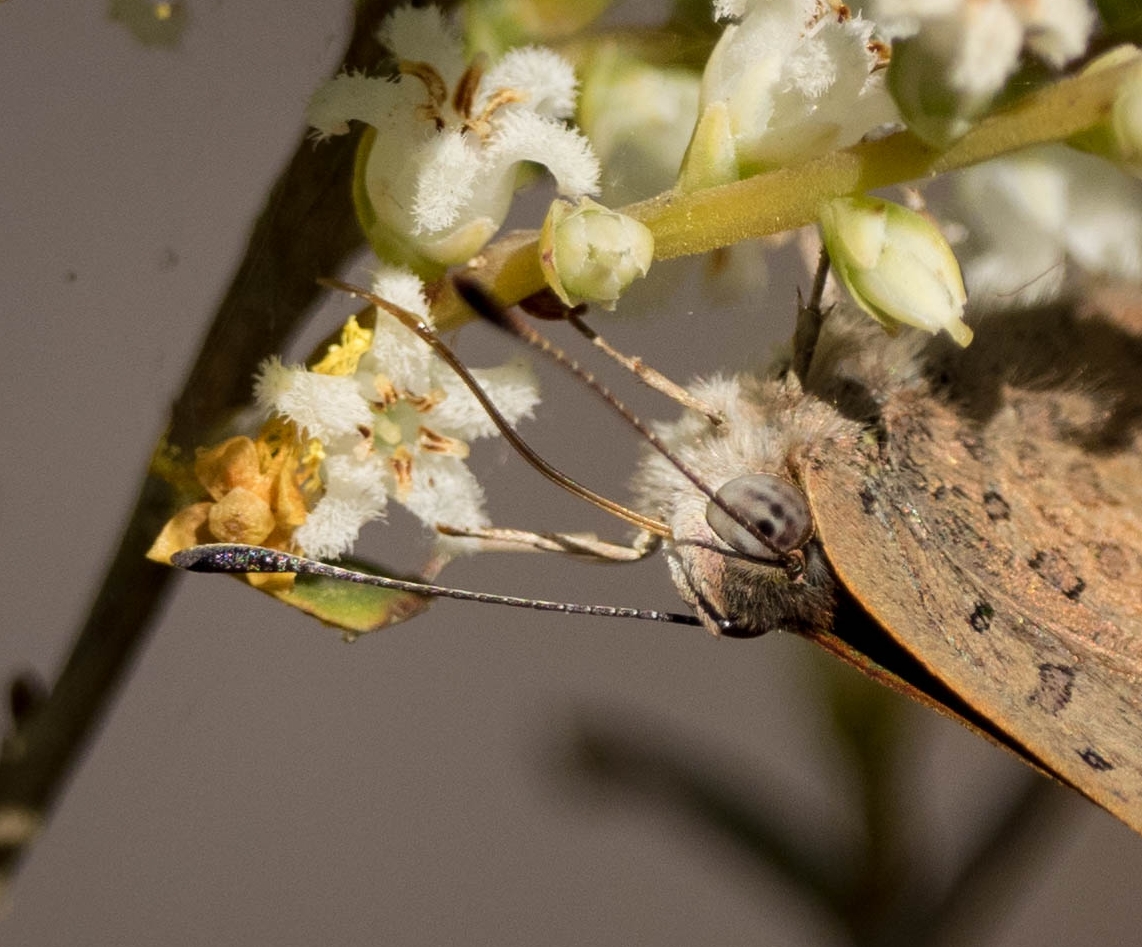Butterfly feeding: a closer look

There are more insects appearing every day now.
The Leucopogon flowers continue to pump out nectar, filling the air with the scent of vanilla and attracting a range of butterflies, bees and wasps. Yesterday I watched on as a beautiful Bright Copper probed the tiny flowers with his long 'tongue'.
This was our first sighting of Bright Coppers (Paralucia aurifer) for the season. Although these butterflies are relatively small, their brilliant colours and iridescence make them impossible to overlook.
The wings of all Lepidoptera (butterflies & moths) are covered in tiny, sculptured scales. These scales diffract light, creating a variety of colours depending upon the viewing angle. In the Bright Copper, the underlying yellow-orange pigment changes hue as the insect opens its wings. And waves of blue-green appear to move across the wing. Very coppery indeed!
This species' life history is just as intriguing. I've yet to find the caterpillars, but this is what I've read: as they grow, the caterpillars feed only at night, tended by ants of a particular genus. Now, here's the amazing part. During the day, these caterpillars hide away in the ants' nest, or in a small hideout that the ants build for them at the base of the plant. And, finally, the caterpillars pupate lying on the floor of the ants' nest, protected from predators and parasites ... and from curious naturalists like me!
Sorry, I digress. This post is really about butterfly feeding ...
Yesterday I stood awhile and watched as this male Bright Copper clambered about on a Leucopogon bush, probing first one flower and then another.
His proboscis would flex and straighten. The two sides of it were clearly visible, yet the whole structure remained intact. He could tip it forward and back, changing the angle at which it projected from the front of his face. And occasionally he seemed to flex it to one side or the other.
Clearly, I thought, this is much more than a simple tube. It made me wonder what was responsible for the movement ... hydraulic pressure or muscles? And to what extent was he using it to sense his environment?
And then he really put on a show! He flew a short distance away from the bush and alighted amongst the leaf litter (taking full advantage of his camouflaged underwings). In an elaborate series of movements I've never seen before, he proceeded to groom.
He first wiped the tip of the proboscis against a piece of bark.
Next, he brushed it clean using the hairs on his front legs, first one side and then the other. Finally, he recoiled the tube and flew off.
So this morning I decided it was time I learned a bit more about the amazing butterfly tongue. A quick search delivered an excellent paper describing the structure and function in detail (Krenn, 2010). Here is a summary of what I discovered:
An elaborate drinking straw
The proboscis is formed by the stitching together of two elongated mouthparts, the 'galea'. Each galea is concave along its inner surface and so when water-tight connections join them together they form a long sucking tube. The dorsal seam toward the tip has gaps that allow fluid intake. There is a pumping mechanism in the head, and so ultimately the proboscis does work like a drinking straw. A very elaborate one.
The proboscis can taste and feel
The galea are complex organs, complete with nerves, sensory structures, and intrinsic muscles. The butterfly can taste liquids, gauging the sugar content. It can locate by feel, determining the depth and width of a floral tube. And it can move the proboscis sideways, flexing the muscles of one galea or the other.
Stitching together happens early and only once
When the insect first ecloses from the pupal case, the galea are separate. They are joined together by surface structures that interlock before the cuticle fully hardens, and they then remain joined throughout life. On reading about this process, I realised we had previously witnessed the interlocking process in action ...
Vanessa kershawi, newly eclosed (January, 2015)
Galea not yet fused throughout
These images show a Vanessa kershawi butterfly newly emerged from its pupal case. We watched as the wings slowly expanded and hardened, the insect eventually able to walk strongly and then fly off. What we had not appreciated at the time was the other transformation that was underway – the pair of galea gradually coming together from the base toward the tip, to ultimately form a functional proboscis. Fortunately we had captured this in a couple of photos. It is not something we are likely to see often.
Now, back to my summary of the Krenn paper ...
Uncoiling and coiling
The proboscis doesn't appreciably change in length when it is 'extended' or 'retracted'. Rather, it is simply flattened and packed away as a tight coil when not in use.
Uncoiling is largely a hydraulic process and occurs in a series of steps
1) Dorsal muscles at the base of the proboscis contract, swinging the coil up and forward. This releases the mechanism that was holding the coil secure and tucked in against the head.
2) The elasticity of the cuticle helps to unravel the coil into a loose 2-3 loops.
3) Other muscles in the head rhythmically contract, pumping body fluid into each of the two galea. The cuticle of the galea is flexible and elastic, accommodating the increased internal pressure by further uncoiling.
Recoiling is a little different, with more muscles involved
1) The hydraulic 'valve' is released, allowing the pressurised body fluid to flow back out of each galea.
2) The elasticity of the cuticle recoils the proboscis into a a loose coil of 2-3 loops.
3) The ventral intrinsic muscles of the galea contract to fully tighten the coil, squeezing most of the remaining body fluid out and flattening the proboscis again.
4) The entire coil is lowered through the action of other head muscles, returning it to the resting position tucked down against the head.
The proboscis has an 'elbow'
About a third of the way along there is an area with a different pattern of elasticity. Small changes in hydraulic pressure therefore enable the insect to 'flex' the proboscis at this point. And this bend has functional significance. It enables butterflies to be quite generalist in their nectar-feeding. They can drink from flowers with floral tubes of various depths by bending the proboscis at the elbow.
But what about those other parts of the face?
In many butterflies the proboscis is flanked by a pair of large, upwardly pointing structures covered in hairs. These 'palps' include a range of sense organs. In at least some moths and butterflies that have been studied in detail, sense organs on the palps can detect carbon dioxide concentrations in the air and the insects can use this as a cue to find flowers. They can even use relative carbon dioxide levels to detect the most nectar-productive flowers. Extraordinary!
(Of course, vision is also a critical sense for butterflies. It has been shown that butterflies use colour vision for finding flowers and that they are far more sensitive to colour than many other insects, including bees - Arikawa, 2017)
With this new insight into how the proboscis works, I look back over yesterday's photos with fresh eyes. I see the proboscis 'elbow' as the Bright Copper tests the depth of each flower. The opening along the dorsal tip is visible as a distinct region, wet with nectar during feeding. And the shape of the proboscis during grooming reflects the second step in the recoiling process - the hydraulic pressure released but the intrinsic muscles yet to rewind and flatten the coil. It all makes much more sense. As does the need to be fastidious with cleaning and maintenance!

